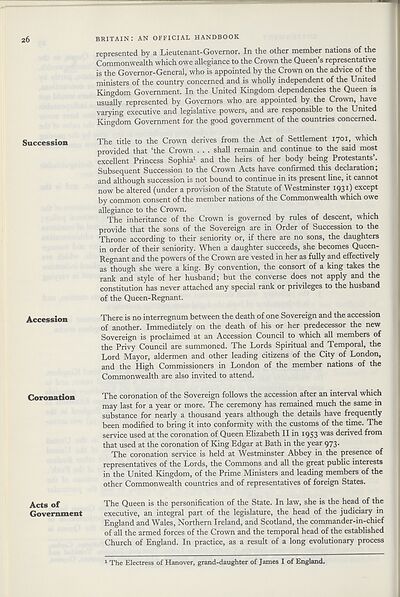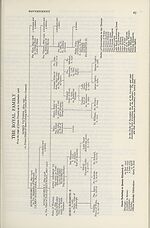Download files
Complete book:
Individual page:
Thumbnail gallery: Grid view | List view

26
Succession
Accession
Coronation
BRITAIN: AN OFFICIAL HANDBOOK
represented by a Lieutenant-Governor. In the other member nations of the
Commonwealth which owe allegiance to the Crown the Queen’s representative
is the Governor-General, who is appointed by the Crown on the advice of the
ministers of the country concerned and is wholly independent of the United
Kingdom Government. In the United Kingdom dependencies the Queen is
usually represented by Governors who are appointed by the Crown, have
varying executive and legislative powers, and are responsible to the United
Kingdom Government for the good government of the countries concerned.
The title to the Crown derives from the Act of Settlement 1701, which
provided that ‘the Crown . . . shall remain and continue to the said most
excellent Princess Sophia1 and the heirs of her body being Protestants .
Subsequent Succession to the Crown Acts have confirmed this declaration;
and although succession is not bound to continue in its present line, it cannot
now be altered (under a provision of the Statute of Westminster 1931) except
by common consent of the member nations of the Commonwealth which owe
allegiance to the Crown.
The inheritance of the Crown is governed by rules of descent, which
provide that the sons of the Sovereign are in Order of Succession to the
Throne according to their seniority or, if there are no sons, the daughters
in order of their seniority. When a daughter succeeds, she becomes Queen-
Regnant and the powers of the Crown are vested in her as fully and effectively
as though she were a king. By convention, the consort of a king takes the
rank and style of her husband; but the converse does not apply and the
constitution has never attached any special rank or privileges to the husband
of the Queen-Regnant.
There is no interregnum between the death of one Sovereign and the accession
of another. Immediately on the death of his or her predecessor the new
Sovereign is proclaimed at an Accession Council to which all members of
the Privy Council are summoned. The Lords Spiritual and Temporal, the
Lord Mayor, aldermen and other leading citizens of the City of London,
and the High Commissioners in London of the member nations of the
Commonwealth are also invited to attend.
The coronation of the Sovereign follows the accession after an interval which
may last for a year or more. The ceremony has remained much the same in
substance for nearly a thousand years although the details have frequently
been modified to bring it into conformity with the customs of the time. The
service used at the coronation of Queen Elizabeth II in 1953 was derived from
that used at the coronation of King Edgar at Bath in the year 973.
The coronation service is held at Westminster Abbey in the presence of
representatives of the Lords, the Commons and all the great public interests
in the United Kingdom, of the Prime Ministers and leading members of the
other Commonwealth countries and of representatives of foreign States.
Acts of The Queen is the personification of the State. In law, she is the head of the
Government executive, an integral part of the legislature, the head of the judiciary in
England and Wales, Northern Ireland, and Scotland, the commander-in-chief
of all the armed forces of the Crown and the temporal head of the established
Church of England. In practice, as a result of a long evolutionary process
1 The Electress of Hanover, grand-daughter of James I of England.
Succession
Accession
Coronation
BRITAIN: AN OFFICIAL HANDBOOK
represented by a Lieutenant-Governor. In the other member nations of the
Commonwealth which owe allegiance to the Crown the Queen’s representative
is the Governor-General, who is appointed by the Crown on the advice of the
ministers of the country concerned and is wholly independent of the United
Kingdom Government. In the United Kingdom dependencies the Queen is
usually represented by Governors who are appointed by the Crown, have
varying executive and legislative powers, and are responsible to the United
Kingdom Government for the good government of the countries concerned.
The title to the Crown derives from the Act of Settlement 1701, which
provided that ‘the Crown . . . shall remain and continue to the said most
excellent Princess Sophia1 and the heirs of her body being Protestants .
Subsequent Succession to the Crown Acts have confirmed this declaration;
and although succession is not bound to continue in its present line, it cannot
now be altered (under a provision of the Statute of Westminster 1931) except
by common consent of the member nations of the Commonwealth which owe
allegiance to the Crown.
The inheritance of the Crown is governed by rules of descent, which
provide that the sons of the Sovereign are in Order of Succession to the
Throne according to their seniority or, if there are no sons, the daughters
in order of their seniority. When a daughter succeeds, she becomes Queen-
Regnant and the powers of the Crown are vested in her as fully and effectively
as though she were a king. By convention, the consort of a king takes the
rank and style of her husband; but the converse does not apply and the
constitution has never attached any special rank or privileges to the husband
of the Queen-Regnant.
There is no interregnum between the death of one Sovereign and the accession
of another. Immediately on the death of his or her predecessor the new
Sovereign is proclaimed at an Accession Council to which all members of
the Privy Council are summoned. The Lords Spiritual and Temporal, the
Lord Mayor, aldermen and other leading citizens of the City of London,
and the High Commissioners in London of the member nations of the
Commonwealth are also invited to attend.
The coronation of the Sovereign follows the accession after an interval which
may last for a year or more. The ceremony has remained much the same in
substance for nearly a thousand years although the details have frequently
been modified to bring it into conformity with the customs of the time. The
service used at the coronation of Queen Elizabeth II in 1953 was derived from
that used at the coronation of King Edgar at Bath in the year 973.
The coronation service is held at Westminster Abbey in the presence of
representatives of the Lords, the Commons and all the great public interests
in the United Kingdom, of the Prime Ministers and leading members of the
other Commonwealth countries and of representatives of foreign States.
Acts of The Queen is the personification of the State. In law, she is the head of the
Government executive, an integral part of the legislature, the head of the judiciary in
England and Wales, Northern Ireland, and Scotland, the commander-in-chief
of all the armed forces of the Crown and the temporal head of the established
Church of England. In practice, as a result of a long evolutionary process
1 The Electress of Hanover, grand-daughter of James I of England.
Set display mode to:
![]() Universal Viewer |
Universal Viewer | ![]() Mirador |
Large image | Transcription
Mirador |
Large image | Transcription
The item on this page appears courtesy of Office for National Statistics and may be re-used under the Open Government Licence for Public Sector Information.
| Britain and UK handbooks > Britain: An official handbook > 1969 > (42) |
|---|
| Permanent URL | https://digital.nls.uk/204651721 |
|---|
| Attribution and copyright: |
|
|---|---|
| Description | 'Britain: An official handbook' was produced annually by the Central Office of Information from 1954-1998. There are 44 volumes available here to view. |
|---|---|
| Shelfmark | GII.11 |
| Description | Three titles produced by the British Government from 1954-2005 describing 'how Britain worked'. They are: 'Britain: An official handbook' (1954-1998), 'Britain: The official yearbook of the United Kingdom' (1999-2001), and 'UK: The official yearbook of the United Kingdom of Great Britain and Northern Ireland' (2002-2005). These 50 reports provide an overview of Britain's economic, social and cultural affairs, its environment, international relations, and the systems of government. They give an impartial summary of government policies and initiatives, and explain how public services are organised. |
|---|---|
| Additional NLS resources: |
|

